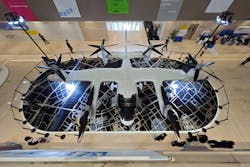FAA issues final rule for pilot training and certification of powered-lift aircraft
WASHINGTON - The Federal Aviation Administration (FAA) has issued a final rule outlining the qualifications and training required for pilots and instructors of powered-lift rotorcraft, which are often referred to as electric vertical take-off and landing (eVTOL), advanced air mobility (AAM), or urban air mobility (UAM) aircraft.
This category of civil aviation combines features of both airplanes and helicopters. These aircraft, which can take off and land vertically like helicopters and fly like airplanes, are expected to be used for urban air taxis, cargo delivery, and other operations, such as first responder transportation.
The FAA’s rule covers operational standards, including minimum safe altitudes and visibility requirements, and creates a framework for safely introducing these eVTOL aircraft into U.S. airspace. The rule marks a step toward integrating these aircraft into the National Airspace System (NAS). The rule does not address unmanned powered lift or certification requirements for autonomous aircraft, which are outside its scope. The document is available here.
Related: EHang and China Southern Airlines announce pilotless eVTOL collaboration
"The FAA will continue to prioritize the safety of our system as we work to seamlessly integrate innovative technology and operations. This final rule provides the necessary framework to allow powered-lift aircraft to safely operate in our airspace, FAA Administrator Mike Whitaker said. "Powered lift aircraft are the first new category of aircraft in nearly 80 years and this historic rule will pave the way for accommodating wide-scale Advanced Air Mobility (AAM) operations in the future."
While the FAA has updated regulations to allow for the commercial use of powered-lift aircraft, this new rule specifically addresses the training of pilots and instructors, which was not covered under existing rules. The agency also released a blueprint last year for how eVTOL vehicles will operate, a key step in advancing the AAM concept.
The new rule makes several changes to existing regulations, including the establishment of a Special Federal Aviation Regulation (SFAR) to facilitate powered-lift pilot and instructor certification. It also applies certain helicopter operating rules to powered-lift aircraft and introduces a performance-based approach to some regulations. The rule allows pilots to train using a single set of flight controls, a shift from legacy rules that required two sets of controls for students and instructors.
Related: Lilium completes initial testing of eVTOL jet propulsion unit
The FAA has decided not to create new requirements or revise existing ones for the type certification of powered-lift aircraft. Instead, it will certify powered-lift aircraft as a special class under § 21.17(b), which allows the FAA to address their unique features without special conditions or exemptions. Since powered-lift aircraft have myriad configurations and are still in development, the agency did not establish specific classes.
The final rule includes pathways for flight training in eVTOL aircraft with a single set of controls. These include using throwover controls for both student and instructor, conducting training in approved simulators, and allowing the FAA to issue deviation authority based on future technological advancements.
About the Author
Jamie Whitney
Senior Editor
Jamie Whitney joined the staff of Military & Aerospace Electronics in 2018 and oversees editorial content and produces news and features for Military & Aerospace Electronics, attends industry events, produces Webcasts, and oversees print production of Military & Aerospace Electronics.
